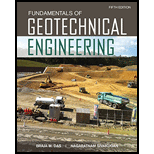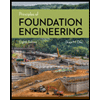
Concept explainers
(a)
Whether the statement “Higher the variability, higher is the coefficient of variation” is true or false.
(a)
Answer to Problem 20.1P
The given statement is
Explanation of Solution
Write the equation of coefficient of variation.
- From Equation (1), the coefficient of variation is directly proportional to the standard deviation.
- The higher variability in data implies higher standard deviation. Hence, the higher standard deviation gives a higher percentage of coefficient of variation.
Therefore, the statement is
(b)
Whether the statement “Coefficient of variation cannot exceed 100%” is true or false.
(b)
Answer to Problem 20.1P
The given statement is
Explanation of Solution
From Equation (1):
The coefficient of variation exceeds 100% when the standard deviation is more than the mean. Hence, the coefficient of variation exceeds 100% is possible.
Therefore, the given statement is
(c)
Whether the statement “The loads used in LRFD are greater than those used in ASD” is true or false.
(c)
Answer to Problem 20.1P
The given statement is
Explanation of Solution
- The allowable strength of the member or component is less than the full strength of member or component.
- In LRFD method, the loads are compared to the full strength of the member; whereas in ASD method, the loads are compared to the allowable strength of the member. Hence, the loads in LRFD method are usually greater than the ASD method.
Therefore, the given statement is
(d)
Whether the statement “The load/resistance factors used for foundations are different from retaining walls” is true or false.
(d)
Answer to Problem 20.1P
The given statement is
Explanation of Solution
- The method for design of foundation is LRFD; while for retain wall, the standard method is used to design.
- Hence, the load/resistance factors for foundations and retaining walls are different.
Therefore, the statement is
(e)
Whether the statement “The load factors in LRFD are generally greater than 1” is true or false.
(e)
Answer to Problem 20.1P
The given statement is
Explanation of Solution
- LRFD design method follows limit state of design approach, where no separate factor of safety is used.
- In the limit state design approach, generally, the loads and resistance factors are already adjusted by partial safety factors. In this design method, ultimate loads are compared to actual loads.
- Hence, the load factors are greater than 1 and resistance factors are less than 1.
Therefore, the given statement is
Want to see more full solutions like this?
Chapter 20 Solutions
Fundamentals of Geotechnical Engineering (MindTap Course List)
- 3. The following table shows the shear test results along the foliation surfaces of gneisses. The area of the discontinuity surface is 6.4*10-3 m2. a) Fill in the table b) Calculate the slip resistance parameters of the gnaysa ). (use millimeter paper) Experiment No. Shearing Normal Load Shearing Normal burden Tensile Stress (kg) (kg) (kg/cm2) (kg /cm? 1 750 500 1400 1200 3 1600 1400 4 2000 1800 2500 3500 6. 3000 4250arrow_forwardA free-headed drilled shaft is shown in Figure P13.10. Let Qg = 260 kN, Mg = 0, = 17.5 kN/m3, = 35, c' = 0, and Ep = 22 106 kN/m2. Determine a. The ground line deflection, xo b. The maximum bending moment in the drilled shaft c. The maximum tensile stress in the shaft d. The minimum penetration of the shaft needed for this analysisarrow_forwardFor the drilled shaft described in Problem 19.7, estimate the total elastic settlement at working load. Use Eqs. (18.45), (18.47), and (18.48). Assume that Ep = 20 106 kN/m2, s = 0.3, Es = 12 103 kN/m2, = 0.65 and Cp = 0.03. Assume 80% mobilization of skin resistance at working load. (See Part c of Problem 19.7) 19.7 Figure 19.16 shows a drilled shaft without a bell. Here, L1 = 6 m, L2 = 7 m, Ds = 1.5 m, cu(1) = 50 kN/m2, and cu(2) = 75 kN/m2. Find these values: a. The net ultimate point bearing capacity. Use Eqs. (19.23) and (19.24) b. The ultimate skin resistance. Use Eqs. (19.26) and (19.28) c. The working load, Qw (FS = 3) FIG. 19.16arrow_forward
- 2. A series of consolidated, undrained triaxial tests were carried out on specimens of a saturated clay under no backpressure. The test data at failure are summarized: Confining Pressure (kPa) Deviator Stress (kPa) Pore Water Pressure (kPa) 150 192 80 300 341 154 450 504 222 a. Draw the Mohr circles and find the cohesion and friction angles in terms of effective stresses. b. Compute Skempton’s A-parameter at failure for all three specimens. c. Is the soil normally consolidated or overconsolidated? Why? d. Another specimen of the same clay that was consolidated under a cell pressure of 250 kPa was subjected to a consolidated, drained triaxial test. What would be the deviator stress at failure?arrow_forwarda. A vane shear test was conducted in a saturated clay. The height and diameter of the rectangular vane were 4 in. and 2 in., respectively. During the test, the maximum torque applied was 230 lb-in. Determine the undrained shear strength of the clay. b. The clay soil described in part (a) has a liquid limit of 58 and a plastic limit of 29. What would be the corrected undrained shear strength of the clay for design purposes? Use Bjerrum’s relationship for λ [Eq. (3.40a)].arrow_forwardTake o, = 580 kPa (Figure 1) Express your answer to three significant figures and include the appropriate units. HÀ ? o, = Value Units Submit Request Answer Figure Part B Determine the shear stress acting on the inclined plane AB. Express your answer to three significant figures and include the appropriate units. В HA ? 30° Value Units Aarrow_forward
- 9. The following are the details for the backfill material in a vibroflotation project. D10=0.36 mm D20 0.52 mm D25=0.60 mm D50=1.42 mm D75 1.65 mm a. Find the suitability number. b. Determine the rating. c. Determine the sorting coefficient.arrow_forwardAt failure, the major and minor principal stresses on a triaxial test are 200 kPa and 110 kPa respectively. If the porewater pressure at failure is 25 kPa... Q: What is the sine of the angle of shearing resistance of the soil? Round off your answer to two decimal places.arrow_forward|!;9 ELABORATE Try solving the following problem: Practice Problem: The following are the results of a consolidation test on a sample soil: a. Plot the e-log o' curve b. Using Casagrande's method, determine the preconsolidation pressure. c. Calculate the compression index, Cc e 1.1 1.085 1.055 1.01 0.94 0.79 0.63 Pressure, o' (ton /ft²) 0.25 0.50 1.00 2.00 4.00 8.00 16.00arrow_forward
- Find active thurst P₁ = ? when tension crack has not yet appeared A B 2 m 3 m C 2 Clay Y₁ = 17 kN/m² 2 c=15 kN/m² $₁ = 20° 3 1₂= 16 kN/m c = 0 (Sand) $₂ = 20°arrow_forwardA sample of sand is sheared in the following manner. First an all around normal stresso 350 kPa is applied to the sample. Next a shear stress is applied to the horizontal pia while the normal stress remains constant. The shear stresses at failure are + 186 kPa. Ihe initial stress and stress condition at failure are shown below 350 kPa 350 kPa 186 kPa 350 kPa 350 kPa ー550 kPa 550 kPa 186 kPa 350 kPa 350 kPa Initial Conditions At Failure Determine the Following: fo A) Assuming c, = 0, draw a failure envelope for the soil. Define the friction angle ( the soil. B) Draw the Mohr's Circle at failure for the test. C) Show the location of the pole. D) Define the maximum and minimum principal stresses at failure. E) Define the normal stress corresponding to the maximum shear stressarrow_forwardCan TRIAXIAL TESTS be performed on sand samples? Briefly explain. The results of an undrained triaxial test on a clay soil sample are given in table below Cell Pressure (kN/m2) 200 400 600 Additional Axial Load at Failure (N) 342 388 465 Each sample, originally 76mm long and 38mm in diameter, experienced a vertical deformation of 5.1mm. Evaluate the stress at failure for each cell pressure given in table above. Draw Mohr Circles and determine the shear strength parameters of the soil.arrow_forward
 Principles of Foundation Engineering (MindTap Cou...Civil EngineeringISBN:9781337705028Author:Braja M. Das, Nagaratnam SivakuganPublisher:Cengage Learning
Principles of Foundation Engineering (MindTap Cou...Civil EngineeringISBN:9781337705028Author:Braja M. Das, Nagaratnam SivakuganPublisher:Cengage Learning Principles of Foundation Engineering (MindTap Cou...Civil EngineeringISBN:9781305081550Author:Braja M. DasPublisher:Cengage Learning
Principles of Foundation Engineering (MindTap Cou...Civil EngineeringISBN:9781305081550Author:Braja M. DasPublisher:Cengage Learning Fundamentals of Geotechnical Engineering (MindTap...Civil EngineeringISBN:9781305635180Author:Braja M. Das, Nagaratnam SivakuganPublisher:Cengage Learning
Fundamentals of Geotechnical Engineering (MindTap...Civil EngineeringISBN:9781305635180Author:Braja M. Das, Nagaratnam SivakuganPublisher:Cengage Learning


